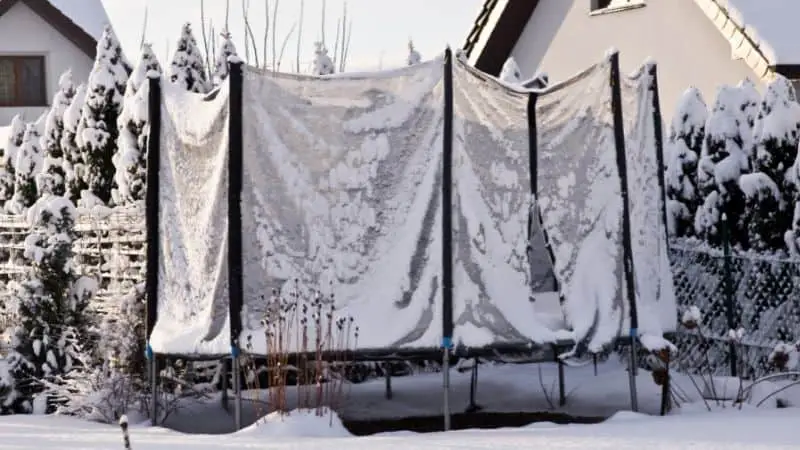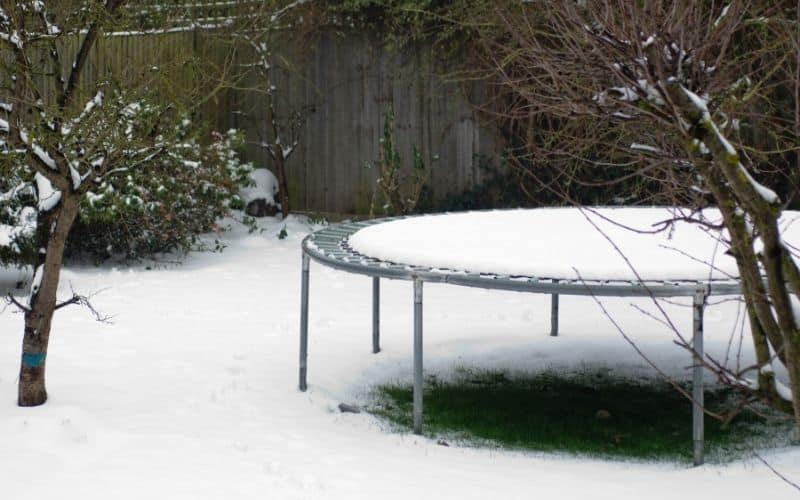Trampolines don’t suddenly become less fun when the weather changes and the temperature drops. In fact, a trampoline in the backyard can help keep kids active during the winter months, which is essential to keep them healthy and out of your hair for at least a little while. But you’ve probably heard that you need to take some precautions to protect your trampoline during winter. Well, no matter what climate you live in — no matter how harsh or mild your winters — I’ve got you covered in this article.
First, let’s answer some common questions about trampolines in winter.
Can You Use a Trampoline in the Winter?
You can absolutely use a trampoline in the winter. Trampolines are made tough, and there’s nothing stopping you from using one in the winter, provided you don’t mind the cold. In fact, wintertime can make for some of the best jumping of the year.
However, whether you’ll want to use the trampoline during the winter months will depend on your tastes and the climate in which you live. In some places, it may just be too cold during the winter to be outside jumping on the trampoline. In other places, the winter may be the best time of year to get trampoline exercise in, especially if the summers are dangerously hot.
But, there’s nothing that makes trampolines inherently dangerous to use in the winter months.
Will a Trampoline Break in the Cold?
Trampolines are built to withstand all types of weather, so you don’t have to worry about yours breaking in the cold. However, there’s something to be said about the quality of your trampoline. Some trampolines are built with more heavy-duty materials than others, helping them last longer in extreme conditions.
It’s not usually the essential aspects of a trampoline that can succumb to cold weather. The springs, jumping mat, and frame will last for many, many winters with proper care. But some trampolines have elastic straps on the pads or on the netting that could become brittle in the cold weather. However, this isn’t something that happens quickly. It usually takes a couple of winters to see this kind of breakdown.
If you’re worried about the trampoline breaking on you because it’s cold outside, don’t. The cold alone will not cause your trampoline to break. But that’s not to say that you shouldn’t perform proper care and winterization if you’re going to leave your trampoline up all winter. And don’t worry, I will cover all that later in this article.
Should You Take a Trampoline Down in the Winter?
If you live in an area that gets a lot of snow, high winter winds, or sudden and extreme drops in temperature during the winter, taking your trampoline down could help make it last longer. But you never have to take your trampoline down in winter, provided you take some basic precautions.
If you plan on using your trampoline during the wintertime at all, you don’t need to take it down. If you don’t think it will get any use, it’s worth it to invest the time to take it down and store it somewhere dry so you don’t have to worry about winter maintenance. After all, if no one is using it, it’s easy to forget to perform winter maintenance.
Will Snow Ruin a Trampoline?
There is some concern about snow on the trampoline. And, to be fair, this concern isn’t unfounded. Snow won’t ruin a trampoline, but if too much of it is allowed to sit on the mat, it could exceed the trampoline’s weight limit. This could stretch the springs and stress the jumping mat, which is best to avoid.
However, this doesn’t mean that you need to be outside while it’s snowing, brushing snow off your trampoline. You don’t. But it is a good idea to brush the snow off of it at your earliest convenience. And yeah, if you see that the forecast calls for a ton of snow, you may want to send one of the kids out to clear off the trampoline so it doesn’t stress the springs.
It’s best to use a broom or a brush to clear off snow from a trampoline, instead of a heated blower or a shovel. The latter two options can damage the trampoline.
Jumping on a Trampoline With Snow
Sometimes a trampoline coated with a layer of snow is just too much fun to pass up. But you may wonder if it’s safe to jump on a trampoline with snow. The answer is yes, provided the weight limit isn’t maxed out. This can be difficult to tell by just looking at the trampoline, but you can use your best judgment. It helps to know your trampoline’s weight limit, of course.
If the trampoline mat is visibly sagging and the springs look like they’re stretching out, there may be too much snow on the trampoline already. But you can always clear some of the snow off and then jump on it. It makes for a fun time as the snow bounces up and all around. Plus playing on a trampoline with snow is an ideal place for a fun snowball fight.
Can All Trampolines be Left Out in the Winter?

Before you decide whether to leave your trampoline outside over the winter, it’s important to check the owner’s manual first. Some trampolines are rated as “all-weather” or “all season.” Other trampolines state explicitly in their owner’s manuals that you should take them down over the winter.
If you don’t see anything one way or the other in your owner’s manual, you can safely assume that you have an all-weather trampoline, as that’s the default. Still, it’s good to look and see what your trampoline manufacturer says about extreme weather.
Ask Around to See How Other Trampolines Have Fared
There are so many different climates and so many different trampolines out there that it can be hard to say one way or another what you should do. However, it’s worth it to ask your neighbors and friends in the area if they know anyone with a trampoline.
By asking around, you can see what other people in your area do with their trampolines. You may hear that people leave them up all year round without any issues. Or you may hear that someone left theirs up for two winters and had to replace the springs because of rust.
If you live in a place that sees a lot of snow, or that’s close to an ocean so there’s salt in the air, your trampoline care during the winter will be different than someone who lives in a mild, dry climate.
How to Winterize Your Trampoline
If you do decide to leave your trampoline out for the winter, there are some essential steps you can take to winterize the trampoline. This will help ensure that you can continue to use your trampoline through this and many winters to come.
Use a Weather Cover
The overall best thing you can do for your trampoline if you leave it out all winter is to use a weather cover when it’s not in use. In fact, these are good for using all year round, as they protect the trampoline not just from snow and rain, but also from UV rays as well.
These covers are easy to install and they can help protect the jumping mat, the frame, and the springs. Not to mention the spring pads.
Remove the Pads When Not in Use
If you don’t end up using a weather cover, you’ll probably want to remove the spring pads when you’re not using the trampoline. This is especially important if you live in a place that has wet winters, as these pads can trap moisture under them, which can cause the springs to rust eventually.
Remove Snow When Convenient
Whether you use a weather cover or not, it’s important to remove the snow from the trampoline whenever it is convenient. As mentioned above, allowing too much snow to sit on the trampoline can max out the weight limit, which can stretch the springs and stress the jumping mat. The weather cover will protect the trampoline from the moisture of the snow, but it can’t protect it from the weight.
Try to Keep it Dry
Keeping a trampoline dry in the winter goes a long way to protect it from the damage that moisture can cause. A dry trampoline won’t rust, which is the number one way things start to break down. The best way to keep it dry is with a weather cover, but a tarp can do the trick too.
Anchor it in Place
When you leave your trampoline up during the winter, it’s important to anchor it down, if you don’t already have it anchored. In many places, winter is a prime season for high winds that can lift a trampoline and send it smashing into other structures (like your house!). Best to avoid this with one of these trampoline anchor kits.
Inspect at Least Once a Month
Hopefully, you’ll be using the trampoline at least a few times during the winter if you leave it up. If so, it’s a good idea to check the trampoline before or after the session to make sure there’s no rust forming. It’s also good to check for loose hardware, making sure to tighten it up if there are any issues. This should be done at least once a month, ideally, during the winter.
Best Practices for Using a Trampoline in the Winter
Now that we’ve covered best practices for leaving the trampoline out during the winter, let’s not forget to cover best practices for using the trampoline.
Check the Weather
Cold is a relative term. If you live in Michigan, cold for you is likely to be in the negatives. Cold for someone who lives in Arizona will be very different. It’s all a matter of perspective. That said, the best thing to do before anyone heads out to jump on the trampoline is check the weather. Specifically, check the wind chill factor, because that often makes things feel much colder. If the temperature and wind chill falls into acceptable limits, then it’s okay to enjoy the trampoline!
Bundle Up
Make sure everyone is dressed appropriately for using the trampoline. Younger kids aren’t as good as adults at regulating their body temperature, so it’s important that they’re bundled up to keep them warm. Plus, it’s easy to work up a sweat on the trampoline, but kids should refrain from removing their warm clothing, as that’s a good way to catch a cold.
However, try not to dress the little ones in anything that can come loose, like scarfs or jackets with string pulleys. These can get caught in the springs or underfoot and cause an injury. Tight-fitting yet warm clothing is the way to go!
Set Time Limits
It’s easy for kids to get carried away on the trampoline. It’s also easy for them to spend too much time out in the cold if they’re having fun. The next thing you know, you have a house full of sick kids. So set time limits for trampoline usage in the winter, and make sure everyone agrees on them before trampoline time starts.
Don’t Jump With Shoes
If it’s chilly out, people may be tempted to jump on the trampoline with their shoes on. This is not a good idea. Jumping with shoes or boots on can damage the trampoline, track debris onto the mat, and can even cause twisted ankles and other injuries. If it’s that cold out, layered socks are the best way to safely enjoy the trampoline in the winter.
Practice Regular Trampoline Safety
Lastly, it’s important to practice regular trampoline safety. Even if there’s a bunch of snow piled around the trampoline, it’s never a good idea for people to deliberately jump off the trampoline, as they can get hurt doing so. If you have an enclosure net, leave it on for the winter. If you don’t, make sure everyone knows what they are and are not allowed to do when jumping on the trampoline.
Conclusion
You’re fine to leave your trampoline out during the winter. Unless, of course, your trampoline’s owner’s manual explicitly says that you shouldn’t leave your trampoline out during the winter. Most trampolines are built for year-round weather. But if you live in a place with extreme winters, you may want to ask around and think hard about leaving your trampoline up. A good rule of thumb is that if people will use it, you can leave it up. If it’s too cold, wet, or snowy for people to use it, you’re better off taking it down.
If you do leave it up, using a trampoline cover and making sure snow isn’t allowed to build upon the trampoline are the best things you can do to prevent premature wear and tear. And when it comes time to jump, make sure everyone is warm and safe!



